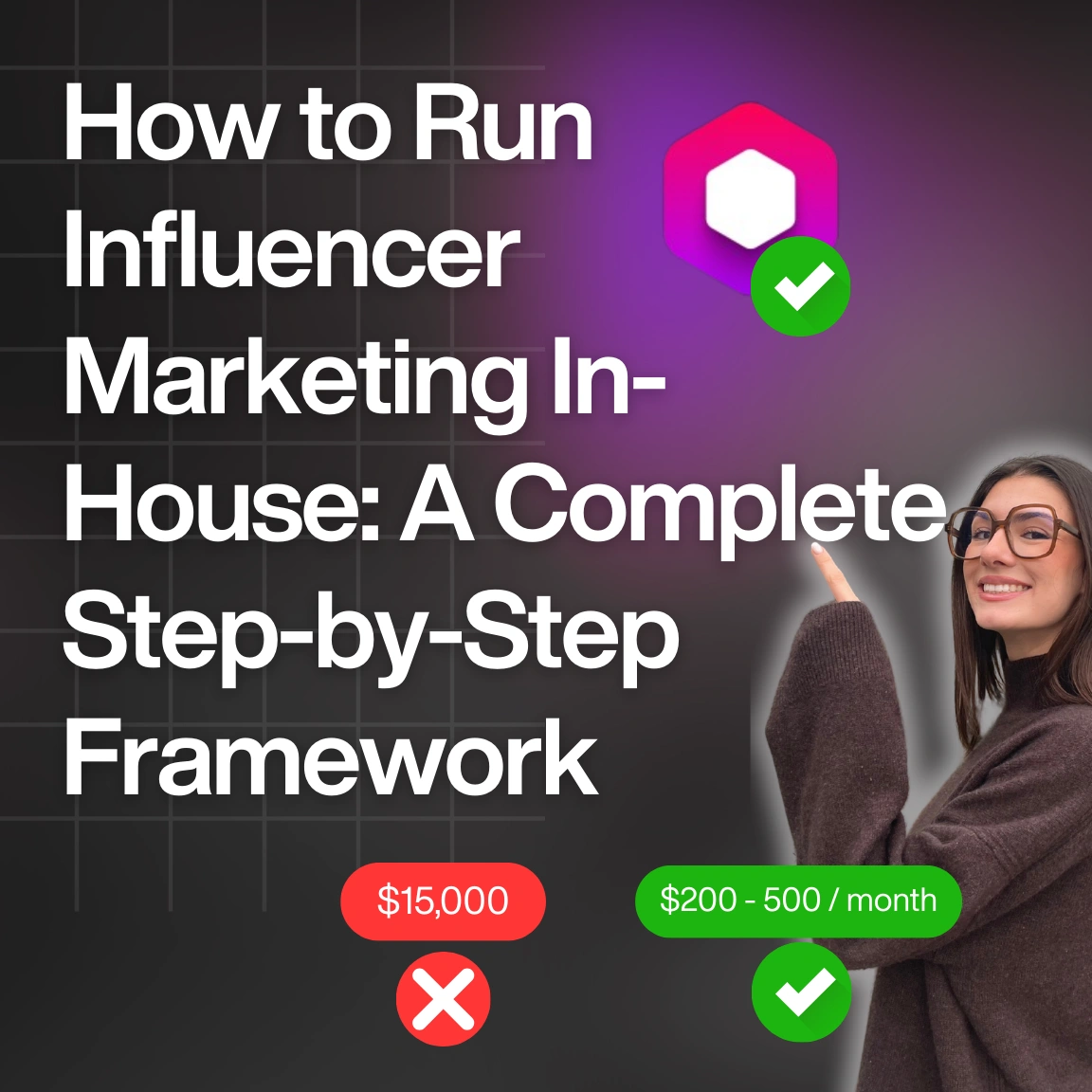Blog & Articles
Your ultimate ressource for the creator economy
Methodology & Rankings
About Favikon, rankings, tools & much more.
Insights
The recipe behind Favikon's viral & coveted rankings.
Free tools to power your influencer marketing workflows.
See Favikon users' success stories.
Get access to all Favikon rankings.
Become a Partner
Become an Affiliate
About the team behind Favikon
The place to talk creator economy, together


Featured Rankings

Here is the Top 50 Rising Video Creators on LinkedIn. Video is quickly becoming the platform’s most powerful format, with creators gaining more reach and engagement than ever. As Gen Z grows its presence and tools like BrandLink and Thought Leader Ads support content creation, LinkedIn is doubling down on video. This ranking, made in partnership with OpusClip, celebrates the creators leading this shift and aims to inspire anyone ready to start sharing through video.

Here is the Top 50 Rising Video Creators on LinkedIn. Video is quickly becoming the platform’s most powerful format, with creators gaining more reach and engagement than ever. As Gen Z grows its presence and tools like BrandLink and Thought Leader Ads support content creation, LinkedIn is doubling down on video. This ranking, made in partnership with OpusClip, celebrates the creators leading this shift and aims to inspire anyone ready to start sharing through video.
How to Set Clear Goals and KPIs for Your Influencer Campaigns
Setting clear goals and KPIs ensures your influencer marketing campaign stays on track and delivers measurable results. This post outlines how to align your objectives with key performance indicators to drive success.

.png)

Josie Renna is a content strategy expert with a passion for helping creators navigate the ever-evolving digital landscape. Specializing in effective content creation techniques and platform-specific strategies, Josie provides insights to empower creators and brands to thrive online. With a deep understanding of algorithm dynamics and audience engagement, Josie shares actionable tips for optimizing content performance across various platforms.
Check Brand DealsHow to Set Clear Goals and KPIs for Your Influencer Campaigns
Setting clear goals and key performance indicators (KPIs) is the foundation of any successful influencer marketing campaign. Without well-defined objectives and measurable metrics, brands risk wasting budget on campaigns that don't deliver meaningful results. In today's competitive digital landscape, where influencer marketing generates $5.78 for every $1 spent, establishing precise goals and KPIs has become more critical than ever.
Why Clear Goals and KPIs Matter in Influencer Marketing
The influencer marketing industry has matured significantly, moving beyond vanity metrics to focus on measurable business outcomes. According to industry experts, campaigns with well-aligned goals are 4× more likely to succeed compared to those without clear objectives.
"The biggest mistake brands make is launching influencer campaigns without specific, measurable goals," says Sarah Johnson, VP of Digital Marketing at Talent Resources. "When you don't know what success looks like, you can't optimize for it."
Clear goals serve multiple purposes: they align internal teams, guide influencer selection, inform content strategy, and provide benchmarks for measuring campaign effectiveness. Without them, you're essentially flying blind in a space where precision determines profitability.
The SMART Framework for Influencer Campaign Goals
Setting Specific, Measurable, Achievable, Relevant, and Time-bound Objectives


The SMART framework has become the gold standard for goal setting in influencer marketing. This approach transforms vague aspirations into concrete, actionable objectives that drive real business results.
Specific: Instead of "increase brand awareness," define exactly what awareness means for your brand. For example, "increase brand mention volume by 40% among the target demographic aged 25-35."
Measurable: Attach numbers to every goal. "Generate 500 qualified leads through influencer content" is far more actionable than "get more leads."
Achievable: Ground your goals in realistic expectations based on your budget, timeline, and market conditions. Setting impossible targets demotivates teams and wastes resources.
Relevant: Ensure goals align with broader business objectives. If your company's priority is customer acquisition, focus on conversion-driven metrics rather than just engagement.
Time-bound: Establish clear deadlines. "Achieve 10,000 new Instagram followers by Q3 end" creates urgency and enables proper resource allocation.
Real-World SMART Goal Examples
- Brand Awareness: "Increase brand reach by 25% among millennials in the beauty category within 90 days"
- Lead Generation: "Generate 300 email signups through influencer-driven landing pages by month-end"
- Sales: "Drive $50,000 in revenue through influencer affiliate links during the holiday season"
Aligning Goals with Brand Strategy and Target Audience
Understanding Your Audience Demographics

Successful influencer campaigns start with deep audience understanding. Your goals must reflect where your target customers spend time and how they consume content. Platform demographics vary significantly, and your objectives should account for these differences.
For instance, if you're targeting Gen Z consumers, TikTok-focused goals around video engagement might be more relevant than LinkedIn-based lead generation metrics. Similarly, B2B brands should prioritize thought leadership and professional network expansion over viral content metrics.
Ensuring Internal Team Alignment
"The most successful campaigns happen when marketing, sales, and social media teams are completely synchronized on objectives," notes Michael Chen, Director of Influencer Strategy at Elastic. This alignment prevents conflicting priorities and ensures everyone works toward the same outcomes.
Create shared documentation that outlines how influencer campaign goals support broader business objectives. When teams understand the connection between influencer metrics and company KPIs, they're more likely to provide necessary support and resources.
Defining KPIs Based on Campaign Objectives
Matching Metrics to Goals
Your KPIs should directly reflect your primary campaign objectives. Different goals require different measurement approaches, and selecting the wrong metrics can lead to misguided optimization efforts.

Advanced KPI Considerations
Modern influencer marketing requires sophisticated measurement approaches. Consider tracking:
- Attribution across touchpoints: How influencer content contributes to multi-touch customer journeys
- Sentiment analysis: The quality of engagement, not just quantity
- Brand lift studies: Changes in brand perception and purchase intent
- Competitive benchmarking: Your performance relative to industry standards
Tools and Analytics for Tracking Performance
Essential Tracking Infrastructure
Implementing robust tracking systems is crucial for accurate KPI measurement. Industry leaders recommend using a combination of native platform analytics, third-party tools, and custom tracking solutions.
UTM Parameters and Tracking Links
Create unique UTM codes for each influencer and campaign to track traffic sources accurately. This enables precise attribution and helps identify top-performing creators.
Promo Codes and Affiliate Links
Unique discount codes and affiliate links provide direct sales attribution. They're particularly effective for e-commerce brands seeking clear ROI measurement.
Social Listening Tools
Monitor brand mentions, hashtag performance, and sentiment across platforms. Tools like Brandwatch, Sprout Social, and Mention provide comprehensive social intelligence.
Favikon's Approach to KPI Tracking

At Favikon, we've developed comprehensive analytics that help brands track influencer campaign performance across multiple dimensions. Our platform enables real-time monitoring of engagement rates, audience quality, and conversion metrics, making it easier for brands to optimize campaigns based on actual performance data rather than assumptions.
Industry Trends in Goal Setting and KPI Measurement
The Shift Toward ROI-Driven Strategies
The influencer marketing industry is experiencing a significant shift toward ROI-driven strategies in 2025. Brands are moving beyond vanity metrics to focus on business outcomes that directly impact revenue and growth.
"We're seeing a maturation in how brands approach influencer marketing," explains Lisa Rodriguez, Senior Analyst at Marketing Evolution. "The focus has shifted from 'how many likes did we get' to 'how much revenue did this generate and at what cost "
Multi-Platform Integration
Modern campaigns increasingly span multiple platforms, requiring sophisticated goal-setting approaches that account for platform-specific behaviors and metrics. Successful brands set platform-specific sub-goals that roll up into overarching campaign objectives.
Enhanced Attribution Models
Advanced attribution modeling is becoming standard practice, with brands tracking influencer impact across the entire customer journey. This includes measuring how influencer content contributes to awareness, consideration, and conversion phases.
Common Mistakes to Avoid
Setting Too Many Goals
One of the most common mistakes is trying to achieve everything at once. Focus on 2-3 primary objectives per campaign to ensure resources and efforts remain concentrated on what matters most.
Ignoring Baseline Metrics
Always establish baseline performance before launching campaigns. Without understanding your starting point, it's impossible to measure true impact or calculate meaningful lift.
Focusing Only on Vanity Metrics
While engagement metrics are important, they shouldn't be your only focus. Ensure your KPI mix includes business-relevant metrics that connect to revenue and growth.
Implementing Your Goal-Setting Framework

Step-by-Step Process
- Define Business Objectives: Start with broader company goals and work backward to influencer-specific objectives
- Research Audience Behavior: Understand where your target customers engage with content and what drives their decisions
- Set SMART Goals: Apply the SMART framework to create specific, measurable objectives
- Select Appropriate KPIs: Choose metrics that directly reflect your goals
- Implement Tracking Systems: Set up analytics and attribution tools before launching campaigns
- Create Reporting Cadence: Establish regular check-ins to monitor progress and make adjustments
Getting Started with Favikon

Favikon's influencer marketing platform provides comprehensive tools for setting, tracking, and optimizing campaign goals. Our analytics dashboard offers real-time insights into campaign performance, helping you make data-driven decisions that improve ROI. Whether you're focused on brand awareness, lead generation, or sales conversion, Favikon's platform provides the measurement infrastructure needed to achieve your objectives.
Conclusion
Setting clear goals and KPIs for influencer campaigns isn't just best practice; it's essential for success in today's competitive landscape. By applying the SMART framework, aligning objectives with business strategy, and implementing robust tracking systems, brands can transform influencer marketing from a creative experiment into a predictable revenue driver.
The key is starting with the end in mind: define what success looks like, establish metrics that measure progress toward that success, and create systems that provide the data needed to optimize performance continuously. With proper goal setting and KPI tracking, influencer marketing becomes a powerful tool for achieving measurable business growth.
Also See 👀
🏆 HOW TO CHOOSE THE RIGHT INFLUENCER MARKETING PLATFORM FOR YOUR BRAND
LAUNCH AND MANAGE INFLUENCER CAMPAIGNS WITH EASE
HOW DOES FAVIKON RANK INFLUENCERS?
Related Articles
See all the articlesResources











.png)










